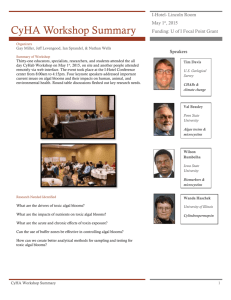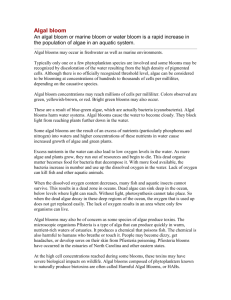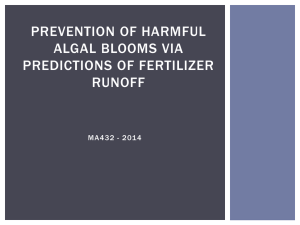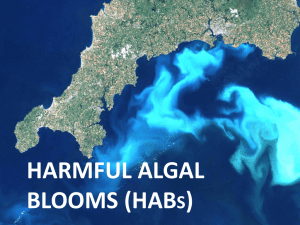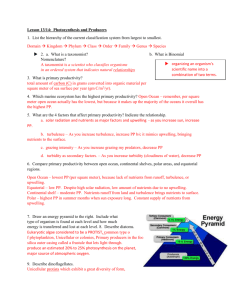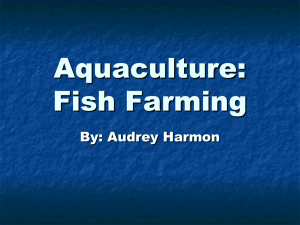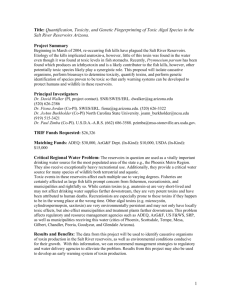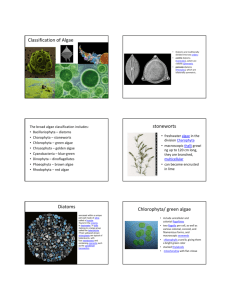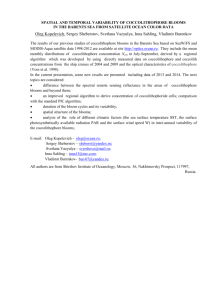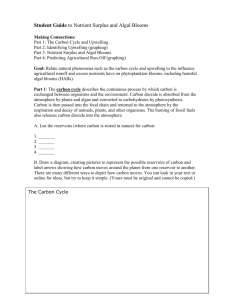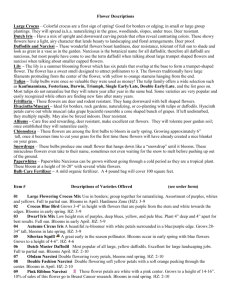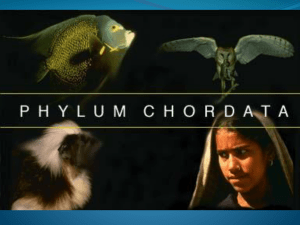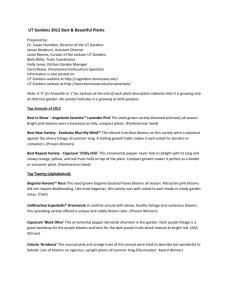A Brief Overview of Freshwater Harmful Algal Blooms Paul Zimba
advertisement
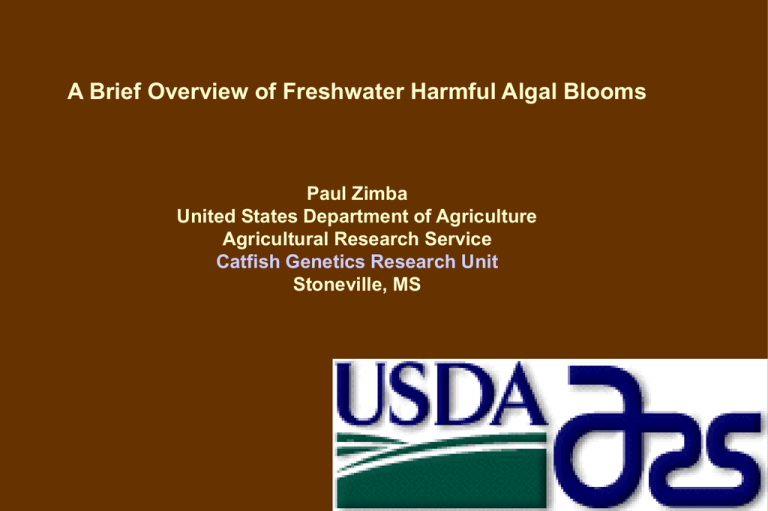
A Brief Overview of Freshwater Harmful Algal Blooms Paul Zimba United States Department of Agriculture Agricultural Research Service Catfish Genetics Research Unit Stoneville, MS Types of Harmful Algal Blooms Produce dense blooms leading to oxygen stress. – – Dinoflagellates, diatoms, raphidophytes, prymnesiophytes Cyanobacteria (prokaryotic microbes) Produce potent toxins—illness and death via food chain or biomass accumulation. – – – – – Paralytic shellfish poisoning (PSP) Diarrheal shellfish poisoning (DSP) Neurotoxic shellfish poisoning (NSP) Ciguatera fishfood poisoning (CFP) Estuary-associated syndrome (EAS) – Amnesic shellfish poisoning (ASP) – Cyanobacterial Toxin Poisoning (CTP) Dinoflagellate Diatom Etiologic agents associated with drinking water outbreaks, in surface water– United States, 1989-2000 (n = 175) 5% 25% Agricultural Impacts Bacteria Chemicals Paramecium/Protozoa Viruses Algae 23% 2% 2% 43% Freshwater Toxins 1) Hepatotoxins – microcystin, cylindrospermopsin, nodularins(?) 2) Neurotoxins – anatoxin-a, prymnesin, anatoxin-a(s), saxitoxin, BMAAs?? 3) Bioactive peptides (ex. anabaenopeptins, anabaenopeptilides) 4) Dermal irritants(?) Microcystins: polypeptide that has >70 structural variants that alter potential toxicity by 20-fold. Principal damage to liver with inhibition of protein phosphatase 2a enzyme. Identification by enzyme inhibition, antibody binding, or HPLC/MS. Mass: 950-1185 AMU Most common substitution sites Impact: Direct Toxic to zooplankton, fish, mammals, plants IndirectAltered food webs Microcystin in Aquaculture Systems Microcystin can kill fish at 60-70 ng/mL Two clonal populations – one strain blooms in winter, whereas the other strain blooms in summer Around 50% of all ponds have measurable microcystin levels based on survey of 485 ponds during July-August (3% of total). 1% of ponds have blooms that exceed WHO guidelines Recently shrimp kill in Texas at <20 ng/mL! Anatoxin-a Neurotoxin that disrupts nerve conductance by irreversibly binding to Na+ channels. Affected organisms include mammals, birds, and fish. Commonly produced by Anabaena, Planktothrix spp. Mass: 164 AMU, requires precolumn derivatization for HPLC identification Direct effect: paralysis, or death. ANATOXIN-a in Aquaculture systems Producers are from Planktothrix aghardii complex Production is limited to temperatures below 16 C Toxin detected in gut contents and water, no extraction method optimized for tissue analyses Prymnesin toxin Produced by Prymnesium parvum (brackish water flagellate species-grows in <2 ppt water) Toxin structure not known, no standards available Toxic to striped bass, channel catfish Confirmed cases in NC, LA, and TX (USA), common in Europe, Asia Forms resting stages-drop salinity <1.5 ppt for control Direct effect: toxicity?, lowered dissolved oxygen/fish kills Indirect effect: food chain alterations “Euglenophycin” produced by E. sanguinea Neurological toxin affecting fish equilibria Structure not fully resolved Toxic to: tilapia, striped bass, catfish, killifish, mammalian tissue culture cell line(s) Cells densities between 800-1,500/mL in surface algal scum during fish mortality events Fish mortalities confirmed using clonal cultures Confirmed mortality events in TX, AR, NC, and MS (USA) and Argentina Direct effect: fish mortalities It is important to appreciate that toxin production is from a microbial community, so understanding role of bacteria, and cyanobacteria is critical. In other consortia, bacteria can stimulate toxin production by fourfold! Other toxins: Cylindrospermopsin: documented from FL, WI (USA), common in Europe, Australia, Africa Producers: Cylindrospermopsis raciborski, Uzbecka spp. Saxitoxin: documented from AL water reservoirs, common in Europe Producers: benthic Lyngbya, Anabaena species Bioactive peptides: serine/threonine inhibitors, neurotoxins/cytotoxins Producers: Microcystis, Oscillatoria, Nostoc Blooms differ (benthic, sub-surface, surface) and recognition of a bloom often occurs late, even after the event! Harmful Algal Blooms include non-toxin producing situations 1) Blooms that increase biomass above baseline levelsin Florida Bay, algal blooms of 10 µg/L exceed the normal chlorophyll concentration by 5-fold. 2) Shading by planktonic algae can shade benthic diatom mats, resulting in replacement by cyanobacteria 3) Dinoflagellate blooms in estuaries result in higher BOD requirements and reduce dissolved oxygen, resulting in rough fish replacing desirable species SPOTTER/ ALIGNMENT MOTOR PLATFORM SENSOR SYSTEM Basic Remote Sensing principles Overflight using AISA push-broom sensor on a Piper Saratoga operated by CALMIT, Univ. of Nebraska Cost : 10K Alternatives: Hand held sensors: convenient light-weight if dual-head – no worries of atmospheric correction- can be used in most weather! cost - $7 – 90K quick – 18 ponds in 1 hr! Submersed Reflectance (OO) 8.5 7.5 5.5 4.5 3.5 2.5 1.5 nm 744.41 685.59 625.08 562.95 499.27 434.12 -0.5 367.56 0.5 nm Reflectance 6.5 55 54 45 53 44 52 43 51 42 50 41 49 40 48 39 47 38 Note three pronounced features from catfish ponds: 705nm suspended solids MAX 676nm chl a trough 624nm phycocyanin trough 20 y = 0.0018x + 4.3392 R2 = 0.23 R440/R550 16 12 8 4 0 0 500 1000 1500 2000 Chlorophyll, mg/m3 2500 3000 3500 RMSE, mg.m3 500 Step 1 l01 =670 nm 450 400 350 300 680 700 720 740 760 l3 780 800 RMSE, mg.m3 500 450 Step 2 l3 =726 nm Step 4 l3 =714 nm By optimizing model fit for the water body, a necessary step for Case 2 waters, it is possible to improve model performance. 400 350 300 600 620 640 l1 660 680 700 RMSE, mg.m3 500 Step 3 l1 =650 nm 450 400 350 300 680 700 720 740 l3 760 780 800 2.0 (R-1650)xR740 = 0.0004xChl + 0.4797 R2 = 0.71, RMSE = 369 mg/m3 Models 1.5 1.0 0.5 (R-1650-R-1710)xR740 = 0.0003xChl - 0.0052 R2 = 0.78, RMSE = 319 mg/m3 0.0 0 500 1000 1500 2000 Chlorophyll, mg/m3 2500 3000 3500 It is critical to realize that one technique does not answer all questions. For instance, counting potentially toxic algae does not tell you if toxins are present, and measuring toxins does not tell which species are involved.

